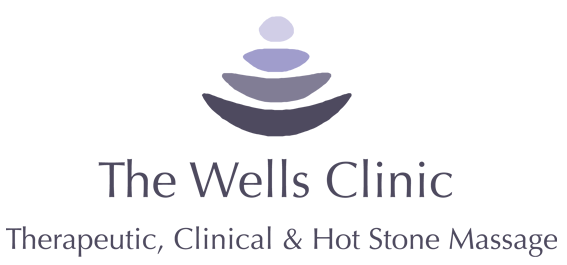Our bodies are built to withstand all manner of injuries and pain, but every trauma we experience causes shortening of our muscles and fascia (that’s the tough connective tissue that holds us together).
We get used to this ‘shortened’ position, our bodies finding us the most comfortable positions to hold, but eventually the pain re-emerges and the longer we ignore it, the longer it takes for the muscles and fascia to return to their normal state.
Among common problem areas is the neck and shoulders, where shortened muscles and 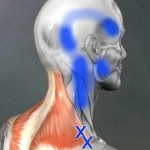 fascia not only cause local discomfort but can also set off tension headaches. The most effective way to treat both is by deactivating what are known as ‘trigger points’, in this instance those in the trapezius muscle.
fascia not only cause local discomfort but can also set off tension headaches. The most effective way to treat both is by deactivating what are known as ‘trigger points’, in this instance those in the trapezius muscle.
What is a trigger point? It feels like a knot in the muscle or fascia, there may be pain when it’s pressed, or it may be tender and radiate pain without pressure. It may also produce what’s known as “referred pain”, that is pain distant from the trigger point, in this case tension headaches.
You’ll find the key trapezius trigger points by pinching a tiny roll of skin where the shoulder joins the neck. There should be a firm strand or cord, as small in diameter as a pencil lead or as thick as a knitting needle. Place your thumb just above the clavicle bone  and your fingers over the shoulder, and massage by rolling the cord between thumb and fingers. If you find that too sore, try positioning a tennis ball on the trigger point and press the ball into a wall.
and your fingers over the shoulder, and massage by rolling the cord between thumb and fingers. If you find that too sore, try positioning a tennis ball on the trigger point and press the ball into a wall.
Doing this may set off or exacerbate a temple headache, or prompt one of the referral pain patterns shown in blue in the diagram. This confirms that you have found at least one trigger point. Only massage for 10–12 seconds until you feel the tension release or the area may end up bruised and sore. You should always work within a pain threshold of 0-10, with 10 being unbearable. Never go beyond 7 to ensure the muscle doesn’t go into spasm.
A source of heat, such as a wheat bag, helps greatly if the area is too painful to massage. Use the bag both before and after de-activating the trigger points, placing it around the neck and over the shoulders. Keep the shoulder blade covered for some of the time you’re applying heat.
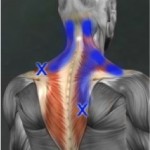 As you can see from the illustrations, there are numerous trigger points in this muscle alone. To de-activate the others you’ll need the help of a tennis ball, which you should place between the section of the back muscle that’s causing pain and a wall. Move the ball across the shoulders, up and down and along the edge of the shoulder blade, and up and down or across towards the spine. Expect to find more than one trigger point at each site, and they may be tender! Remember not to go above 7 on your pain threshold.
As you can see from the illustrations, there are numerous trigger points in this muscle alone. To de-activate the others you’ll need the help of a tennis ball, which you should place between the section of the back muscle that’s causing pain and a wall. Move the ball across the shoulders, up and down and along the edge of the shoulder blade, and up and down or across towards the spine. Expect to find more than one trigger point at each site, and they may be tender! Remember not to go above 7 on your pain threshold.
Once you’ve relieved the tension, try these stretches to help your neck and shoulders stay looser…
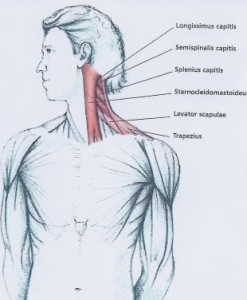 Stand upright while keeping your shoulders still, your head up and your chin facing towards one shoulder. Do not let your chin drop, and hold for 20 seconds. Repeat three times on each side.
Stand upright while keeping your shoulders still, your head up and your chin facing towards one shoulder. Do not let your chin drop, and hold for 20 seconds. Repeat three times on each side.
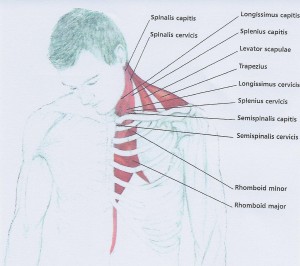 Stand upright and let your chin fall forward towards your chest. Then gently lean your head to one side. Relax your shoulders and keep your hands by your side. Some people are more flexible in the upper back and neck than others. Do not overstretch by forcing your head down — just relax and let the weight of your head do the stretching for you.
Stand upright and let your chin fall forward towards your chest. Then gently lean your head to one side. Relax your shoulders and keep your hands by your side. Some people are more flexible in the upper back and neck than others. Do not overstretch by forcing your head down — just relax and let the weight of your head do the stretching for you.
You can find out more about trigger point therapy here, and I’m always happy to email you further advice on both stretching and self-treatment — just get in touch!
And don’t forget the Wells Clinic Summer offer — save £10 on a hour-long therapeutic massage session (£50 rather than £60).
